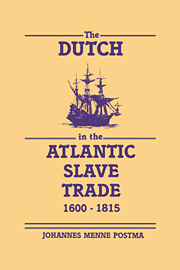Book contents
- Frontmatter
- Contents
- List of tables, figures, and maps
- Preface
- 1 Foundations of the slave traffic, 1600–61
- 2 Curaçao and the asiento trade, 1650–1730
- 3 The Dutch on the West African coast
- 4 Trade and politics on the African coast
- 5 Volume of African exports and origins of slaves
- 6 Organization and mechanics of the trade
- 7 The triangular trade
- 8 The Dutch plantation colonies under WIC monopoly, 1618–1738
- 9 The era of the free trade, 1730–80
- 10 The slaves: their treatment and mortality
- 11 Finances, marketing, and profitability
- 12 The end of the Dutch slave trade, 1781–1815
- Appendixes
- Bibliography
- Index
6 - Organization and mechanics of the trade
Published online by Cambridge University Press: 16 September 2009
- Frontmatter
- Contents
- List of tables, figures, and maps
- Preface
- 1 Foundations of the slave traffic, 1600–61
- 2 Curaçao and the asiento trade, 1650–1730
- 3 The Dutch on the West African coast
- 4 Trade and politics on the African coast
- 5 Volume of African exports and origins of slaves
- 6 Organization and mechanics of the trade
- 7 The triangular trade
- 8 The Dutch plantation colonies under WIC monopoly, 1618–1738
- 9 The era of the free trade, 1730–80
- 10 The slaves: their treatment and mortality
- 11 Finances, marketing, and profitability
- 12 The end of the Dutch slave trade, 1781–1815
- Appendixes
- Bibliography
- Index
Summary
The sinews of the Dutch slave trade were in Holland, where the whole complex system of obtaining slaves and disposing of them was ultimately arranged. During the first century of the Dutch involvement in the traffic, the WIC had complete mastery of this system, but during the free-trade period the company's role was largely limited to administrative and intermediary commercial functions. This chapter focuses on the organization of the slave trade, examining the regional distribution of the Dutch participation, and the techniques employed in obtaining the slaves in Africa and disposing of them in the Americas.
The WIC as manager of the slave trade
The WIC was not chartered for the purpose of the slave trade, however, a few decades after its organization the traffic became one of its main interests. By the 1670s one of the nine committees of the Amsterdam chamber governing board dealt exclusively with the slave trade, and the supreme directorate of the WIC, the Heren X (and before 1674 the Heren XIX), also devoted much attention to this subject.
As a typical joint-stock company, or corporation of that time, the WIC was totally dominated by its major investors, or hoofdparticidpanten. To belong to this illustrious group one had to purchase shares in the company amounting to 6,000 guilders through the Amsterdam chamber or 4,000 through one of the other chambers. There must have been 150 to 200 of these major stockholders, for Amsterdam alone had 83 at one time.
- Type
- Chapter
- Information
- The Dutch in the Atlantic Slave Trade, 1600–1815 , pp. 126 - 148Publisher: Cambridge University PressPrint publication year: 1990



